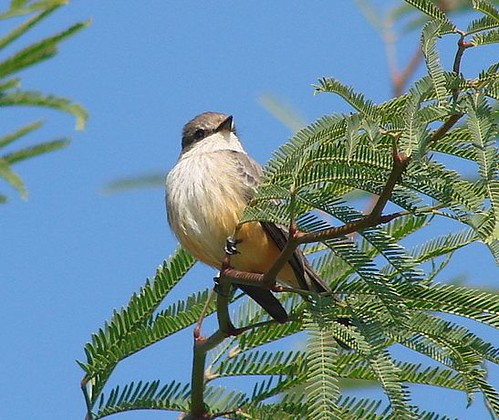tags: birding, bird watching, birds, mystery bird, bird ID quiz
[Mystery bird] Vermilion Flycatcher, Pyrocephalus rubinus, photographed in Arizona. [I will identify this bird for you tomorrow]
Image: Rick Wright [larger view].
Please name at least one field mark that supports your identification.
Rick Wright, Managing Director of WINGS Birding Tours Worldwide, writes:
Neatly hidden away in the mesquite leaves, this bird's tail isn't going to be of much use to us, beyond ruling out any species that is caudally either extravagantly short or long. Those leaves help us as much as they hinder, though: this is obviously a pretty tiny bird, and a lightweight one, too, perched as it is on a petiole!
The upright posture, long wingtip, broad-based bill, and alert expression direct us to the tyrant flycatchers. The blackish mask, white throat, and blurry breast streaking are consistent only with Vermilion Flycatcher, an identification neatly confirmed by the scalloped wingbars and gentle apricot suffusion on the belly and vent. Many female Vermilion Flycatchers are pinker beneath, and not a few are yellower; this lovely golden tone might recall the underparts of Say's Phoebe, a common confusion species, but that bird is much larger, more uniformly colored, plainer-faced, and stouter-billed. Say's Phoebe also prefers treetop or wire perches, while Vermilion Flycatchers like this one often hunt from a perch just inside the foliage.
A bright male Vermilion Flycatcher comes close to being unmistakable, but the brown birds can be confusing at first for those without experience with the species. It's a very good idea to learn the range of appearance of females and young birds, though, as this fine little flycatcher is a regular vagrant all across North America. You don't want to overlook one when it shows up in your area!


Well, it's a kingbird. Cant see the tail too well, if white outer retrices were visible, it would be a lock.
The dark ear-patch and light-edged coverts...I'm going to go with the long-shot and call Tropical kingbird.
I'm going to take a bit of a flyer here, and say that that's a female Vermillion Flycatcher. I'd like for the coloring in the vent area to be a bit pinker, but I like the faint streaking, and what I can see of the markings on the face. And that color downstairs really looks odd to me for birds I'm more familiar with, like Say's Phoebe and Kingbird.
Well, we all knew that the Animaniacs weren't totally original...
http://www.youtube.com/watch?v=lOS1EF4XQYs
Oops. Sorry, wrong entry. This was intended to be for "the elements song"
"I'm going to take a bit of a flyer here, and say that that's a female Vermillion Flycatcher."
Hmmm...that's an interesting call.
My husband refers to this as one of the most frequently misidentified birds in the Southwest. It does indeed look a bit like a Say's Phoebe or a kingbird, but the compact, broad-shouldered shape (like a male Vermilion, a.k.a. "Mr. Wonderful") and the faint breast streaking give it away.
John, in my experience (which includes Texas, Mexico, and Central America as well as Arizona), the belly color on female Vermilions can be anything from plain whitish or faint yellow in some juvenile females to pale peachy orange as in this bird to a bright strawberry pink. Less than two hours ago I was at Whitewater Draw Wildlife Area near Bisbee, AZ enjoying a young female with about as much powder pink on her belly as this bird has pale orange.
Lucky for me, this bird is common here in the Patzcuaro, Mexico area: Female Vermilion flycatcher. Nice photo.
The moment I saw the photo, I knew it was a Say's Phoebe. The shape of the bill is that of a flycatcher. The upright manner in which the bird is perching is characteristic of a flycatcher. The ochre wash into the flanks is diagnostic of Say's Phoebe.